四年级问句答语
四年级英语常见问句类型

四年级英语常见问句类型1. 特殊疑问句特殊疑问句由“特殊疑问词+一般疑问句”构成,其中,特殊疑问词如what(什么)、where (哪里)、how(怎样)等。
回答这类问题需要根据情况进行作答。
例如:Q: What time is it?A: It's 8 o'clock.(问:几点了?答:8点了。
)Q: Where are you from?A: I'm from Beijing.(问:你来自哪里?答:我来自北京。
)2. 选择疑问句选择疑问句是一种提出两个或两个以上可能的答案供对方选择的疑问句,常用一般疑问句的形式。
例如:Q: Shall we go shopping today or watch a movie tomorrow?(问:我们今天去购物还是明天去看电影?)A: Let's go shopping today.(答:今天我们去购物吧。
)3. 反义疑问句反义疑问句是附加在陈述句之后,对陈述句所表示的事实提出询问的疑问句。
其构成一是陈述句加上简短的反义疑问句,二是陈述句加上简短的不定式。
例如:Q: The young man is a doctor, isn't he?(问:那个年轻人是一名医生,不是吗?)A: Yes, he is a doctor.(答:是的,他是一名医生。
)以上三种类型的问句是四年级英语中最常见的问句类型,学生们可以通过多加练习来掌握它们的结构和用法。
除了问句的练习,学生们还可以通过对话、角色扮演等形式来提高自己的英语口语和表达能力。
注意,英语学习需要长期的积累和不断的实践,不要急于求成,要注重基础知识的掌握和实际应用能力的培养。
同时,要善于总结和归纳,掌握学习技巧,提高学习效率。
人教英语PEP版四年级上册_Unit4_知识详解

Unit4 知识详解A Let’s talk 知识详解重难点1. 询问人/物品具体位置的句型(1)——Where is ...?课文应用:Where is she? 她在哪儿?She’s in the kitchen. 她在厨房里。
句型结构:问句:Where is + 人/物品(单数)(she, my sister, my bag...)?答语:人/物品+ is + 表示地点的介词短语(in the room, on the desk, on the wall...). 重点解析:问句:是一个由where引导的特殊疑问句,用于询问人或物品的具体位置,属于wh问句(be型)基本框架:疑问词+ be动词+ 人/物?Where is she?where意为“在哪儿”,有以下几种用法:①询问物品的位置。
例如:Where is my bag? 我的包在哪儿?②询问某人的位置。
例如:Where is Miss Bai? 白小姐在哪儿?③询问某个地方的具体位置。
例如:Excuse me, where is the post office? 打扰一下,邮局在哪儿?生活实例:Jack找不到他的足球了,于是他问妈妈:Jack: Mum, where is my football? 妈妈,我的足球在哪儿?Mum: It is under the bed. 它在床下面。
易错提示:使用这个句型的时候,不要受汉语的影响而丢掉be动词(is)。
此外,这个句型中需要使用表示人或物品的单数名词/代词。
2. 确认人/物品具体位置的句型(1)课文应用:Is she in the living room? 她在客厅里吗?No, she isn’t. 不,她不在。
句型结构:问句:Is + 人/物品(单数)(she, my sister, my bag...) + 表示地点的介词短语(in the room, on the desk, on the wall…)?答语:Yes, he/she/it is. /No, he/she/it isn’t.重点解析:这个问句用于确认人或物品的具体位置,属于Be型疑问句,基本框架:Be动词+ 人/物+ 其他?Is she in the living room?我们已经在前面学习过用where来询问人或物品的具体位置,这里我们学习用is 引导的一般疑问句来确认单数的人或物品的具体位置。
四年级根据问句写答语

G4上(新)根据问句选答语1.Where are you? 1. I’m behind the tree /on your left2.Where’s the park? 2.Turn left . It’s next to a supermarket.3.Thank you . 3.You’re welcome4.Where’s the train? 4.It’s up /down the hill/at the station5.Where’s the train? 5. It’s near the house.6.Where’s the supermarker? 6. Go straight on. Turn left.7.What are you doing ? 7. I’m listening to music .8.What’s Tom doing ? 8. He’s reading a book about China9.What are they doing? 9.They’re playing football.10.Do you want some noodles? 10. Yes,please./No, thank you.Yes, I do /No,I don’t11.How much is it? 11.Ten yuan12.Can I help you? 12. Of course,We want some eggs,please.13.Here you are. 13. Thank you14.Can you run fast? 14. Yes,I can /No, I can’t.(I’m afraid I can’t)15.Can I have some bread? 15.Yes, you can./No, you can’t.Yes,Here you are.(sorry, you can’t)16.Happy Birthday! 16. Thank you.17.Can I come in? 17. Yes, of course.18.What are you going to do?18.We’re going to visit Hainan19.What are you going to do?19.I’m going to do the high jump.20.Are you going to run on sports? 20.Yes, I am/ No, I’m not.。
PEP人教版四年级英语上册《Unit1_知识详解》(附答案)
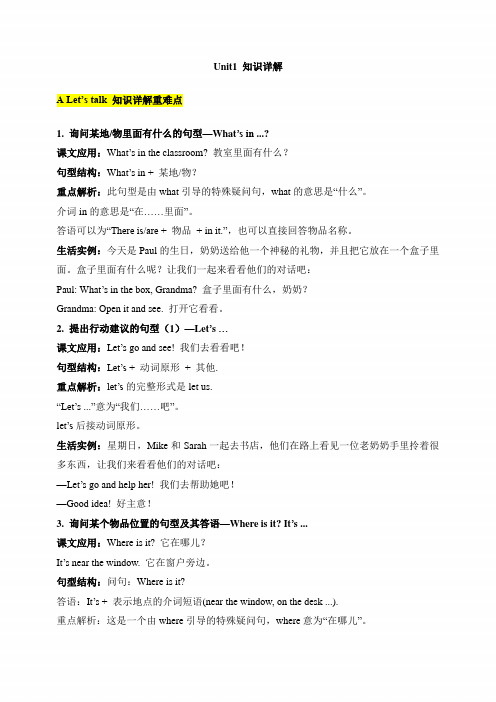
Unit1 知识详解A Let’s talk 知识详解重难点1. 询问某地/物里面有什么的句型—What’s in ...?课文应用:What’s in the classroom? 教室里面有什么?句型结构:What’s in + 某地/物?重点解析:此句型是由what引导的特殊疑问句,what的意思是“什么”。
介词in的意思是“在……里面”。
答语可以为“There is/are + 物品+ in it.”,也可以直接回答物品名称。
生活实例:今天是Paul的生日,奶奶送给他一个神秘的礼物,并且把它放在一个盒子里面。
盒子里面有什么呢?让我们一起来看看他们的对话吧:Paul: What’s in the box, Grandma? 盒子里面有什么,奶奶?Grandma: Open it and see. 打开它看看。
2. 提出行动建议的句型(1)—Let’s …课文应用:Le t’s go and see! 我们去看看吧!句型结构:Let’s + 动词原形+ 其他.重点解析:let’s的完整形式是let us.“Let’s ...”意为“我们……吧”。
let’s后接动词原形。
生活实例:星期日,Mike和Sarah一起去书店,他们在路上看见一位老奶奶手里拎着很多东西,让我们来看看他们的对话吧:—Let’s go and help her! 我们去帮助她吧!—Good idea! 好主意!3. 询问某个物品位置的句型及其答语—Where is it? It’s ...课文应用:Where is it? 它在哪儿?It’s near the window. 它在窗户旁边。
句型结构:问句:Where is it?答语:It’s + 表示地点的介词短语(near the window, on the desk ...).重点解析:这是一个由where引导的特殊疑问句,where意为“在哪儿”。
课文中所用的it是代词,用来代替上文中出现的某个物品。
四年级英语下册人教PEP版_Unit3_知识详解

Unit3 知识详解A Let’s talk 知识详解重难点1. 表示请求的句型及其答语—Can I ...? Yes, you can. / No, you can’t.课文应用:Can I go outside now? 现在我能出去吗?No, you can’t. 不,你不能。
句型结构:问句:Can I + 动词原形+ 其他?答语:Yes, you can. / No, you can’t.重点解析:此句型是由情态动词can引导的一般疑问句,用于询问对方是否允许自己做某事。
can用来表示“请求,许可”,后面直接加动词原形,没有人称和数的变化。
can 的否定式为can not,可缩写为can’t.口语中也常用“Certainly. / Sure. / Of course.”表示同意对方的请求。
生活实例:粗心的Tom把橡皮落在家里了,他只好向他的好朋友Amy求助,下面让我们看一看他们的对话吧:Tom: Can I use your eraser? 我能用你的橡皮吗?Amy: Yes, you can. 是的,你能。
知识拓展:“May I ...?”表示“请求”“May I ...?”这个句型也可以用来表示“请求”。
但是在使用时比“Can I ...?”更加委婉、客气,适用于比较正式的场合或陌生人之间。
例如:May I help you? 我可以帮助你吗?May I sit here? 我可以坐在这儿吗?A Let’s talk知识详解拓展点1. 招待客人Have some + 食物。
如果有朋友到你家做客,你作为小主人,可以用“Have some + 食物.”来招待客人。
例如:Have some orange juice. 喝一些橙汁。
Have some apples. 吃一些苹果。
Have some bread, please. 请吃一些面包。
2. be careful的用法课文应用:Be careful! 小心!同学们,你们知道怎么在紧急情况下提醒别人注意吗?口语“Be careful!”行动快,常常在事件发生前及时赶到并提醒你。
四年级英语上册第一单元的必背知识点
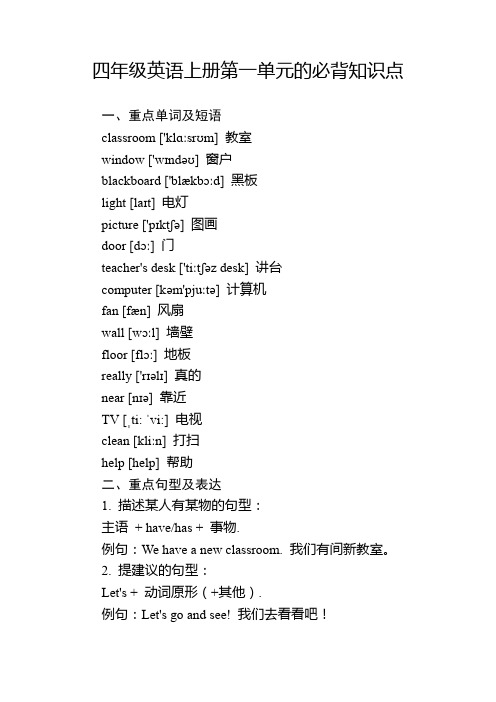
四年级英语上册第一单元的必背知识点一、重点单词及短语classroom ['klɑːsrʊm] 教室window ['wɪndəʊ] 窗户blackboard ['blækbɔːd] 黑板light [laɪt] 电灯picture ['pɪktʃə] 图画door [dɔː] 门teacher's desk ['tiːtʃəz desk] 讲台computer [kəm'pjuːtə] 计算机fan [fæn] 风扇wall [wɔːl] 墙壁floor [flɔː] 地板really ['rɪəlɪ] 真的near [nɪə] 靠近TV [ˌti: ˈvi:] 电视clean [kliːn] 打扫help [help] 帮助二、重点句型及表达1. 描述某人有某物的句型:主语+ have/has + 事物.例句:We have a new classroom. 我们有间新教室。
2. 提建议的句型:Let's + 动词原形(+其他).例句:Let's go and see! 我们去看看吧!3. 询问某地/某物里面有什么的问句及答语:问句:What's in +某地/某物?答语:There is/are +物品+其他./物品名称.例句:What's in the classroom? 教室里有什么?One blackboard, one TV, many desks and chairs. 一个黑板,一台电视,很多桌椅。
4. 询问某物在哪里的问句及答语:问句:Where is +物品?答语:It's +表示地点的介词短语.例句:Where's my schoolbag? 我的书包在哪里?It's near the computer. 在电脑旁边。
三、重点知识及语法1. 介词的使用:掌握介词in、on、under、near的用法及翻译,用于描述物品的位置关系。
人教版四年级英语上册正确答语练习

人教版四年级英语上册正确答语练习【】 1、Are they in the living room ? A. Yes,he is【】 2、Is this your father ? B. I’d like some chicken【】 3、What’s his name ? C. No,they aren’t【】 4、Can I have some noodles ? D.His name is Mike【】 5、What would you like for dinner ? E. sure,Here you are四、根据问句找答句。
【】1、What colour are your pant? 【】2、How many students are there in your class?【】3、What time is it now? 【】4、Whose shoes are these?【】5、What’s the weather like in HongKong? 【】6、Can I wear my new T-shirt today?【】7、May I have a look? 【】8、Where is the washroom?【】9、Are they your white socks? 【】10、Is it cold in Zhanjiang now?A、Yes, you can.B、No, it’s not.C、It’s on the second floor.D、Sure. Here you are.E、They are white.F、It’s cool and cloudy.G、Yes, they are.H、It’s ten o’clock.I、They are my brother’s. J、There are fifty-five.四、选择正确的答语。
【】1、How much is the T-shirt? 【】2、What’s the weather like today?【】3、Can I help you? 【】4、What colour is your brother’s jacket?【】5、What time is it now? 【】6、Where are the washroom?【】7、Are they pretty? 【】8、How much are the shorts?【】9、Is this your sister’s dress? 【】10、Whose pants are these?A、It’s on the first floor.B、No, it’s not.C、They are fifteen yuan.D、It’s brown.E、They are my father’s.F、Yes, please.G、It’s sunny.H、It’s eight o’clock.I、Yes, they are. J、It’s thirty yuan.三、选择正确的答句。
小学英语给下列的问句选择正确的答语

给下列的问句选择正确的答语。
( ) 1. What's the timeA. Yes. I sometimes read newspapers.( ) 2. What do they do after school B.He goes to work by car.( ) 3. When are you going to the hospital C. No, it isn't. ( ) 4. Do you read newspapersD. It's going to be snowy tomorrow.( ) 5. Shall we go to the museum E. Yes, I can.( ) 6. Is there a zoo in your town F. It's ten o'clock. ( ) 7. How does your father go to workG. I'm going to the hospital at three o'clock.( ) 8. Is your school far away from your home H. No, there isn't. ( ) 9. What's the weather like tomorrowI. They often play football.( ) 10. Can you ride a bike J. OK. Let's go.读句子找出相应的答语。
( ) to our school . A. You are welcome .( ) was your trip B. It was very wonderful .( ) you ! C. Nice to see you,too .( ) you have breakfast D. Thank you .( ) many students are there in your class E. There are forty-five.( ) to see you . F. They will leave tomorrow.( ) was Lucy born G. Yes, I did .( ) will they leave for London H. She was born in America读句子找出相应的答语。
Unit5FreeTime空闲时间(素材)人教新起点版英语四年级下册
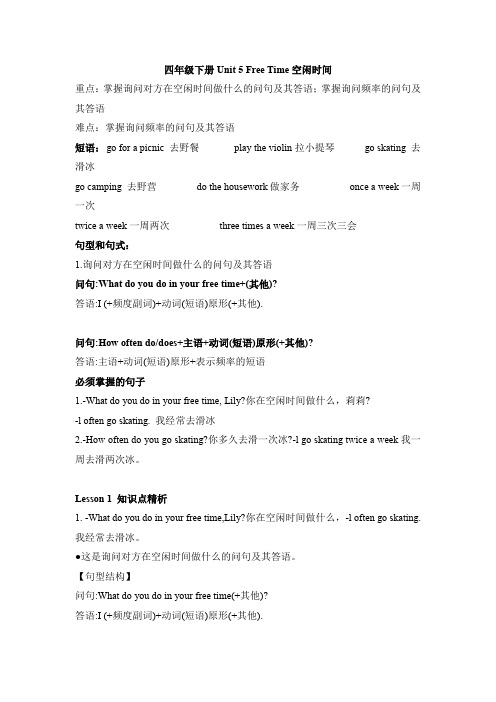
四年级下册Unit 5 Free Time空闲时间重点:掌握询问对方在空闲时间做什么的问句及其答语;掌握询问频率的问句及其答语难点:掌握询问频率的问句及其答语短语:go for a picnic 去野餐play the violin拉小提琴go skating 去滑冰go camping 去野营do the housework做家务once a week一周一次twice a week一周两次three times a week一周三次三会句型和句式:1.询问对方在空闲时间做什么的问句及其答语问句:What do you do in your free time+(其他)?答语:I (+频度副词)+动词(短语)原形(+其他).问句:How often do/does+主语+动词(短语)原形(+其他)?答语:主语+动词(短语)原形+表示频率的短语必须掌握的句子1.-What do you do in your free time, Lily?你在空闲时间做什么,莉莉?-l often go skating. 我经常去滑冰2.-How often do you go skating?你多久去滑一次冰?-l go skating twice a week我一周去滑两次冰。
Lesson 1 知识点精析1. -What do you do in your free time,Lily?你在空闲时间做什么,-l often go skating. 我经常去滑冰。
●这是询问对方在空闲时间做什么的问句及其答语。
【句型结构】问句:What do you do in your free time(+其他)?答语:I (+频度副词)+动词(短语)原形(+其他).例: -What do you do in your free time?你在空闲时间做什么? -I often read books.我经常看书。
-What do you do in your free time, Colin?你在空闲时间做什么,科林?-I often go for a picnic with my parents.我经常和我父母去野餐。
2024秋四年级英语上册情景交际一问答匹配(PEP人教版)

情景交际一:问答匹配时间:40分钟满分:60分一、[浙江省杭州市]读一读,选出正确的答句。
(10分)( )1. Where are your storybooks?( )2. What's your sister's job?( )3. Would you like some beef?( )4. What's in your schoolbag?( )5. Are they under the chair?A. Yes, please.B. No, they aren't.C. They are on the desk.D. She is a nurse.E. A Chinese book and some toys.二、选择合适的选项,补全对话。
(20分)A. How many people are there in your family?B. His name is Zhang Peng.C. He is in the living room.D. Would you like a spoon?三、根据图片提示,从方框中选择合适的句子组成五组对话,将序号填入图片下的方框内。
(每个句子只能用一次)(30分)A. What's your aunt's job?B. It's near the window.C. She is a teacher.D. What would you like?E. What's in your schoolbag?F. Where is the fan?G. Yes, they are.H. I have a toy in my schoolbag.I. Are they in the living room?J. I'd like some noodles.情景交际一:问答匹配一、1. C 2. D 3. A 4. E 5. B二、1. B 2. C 3. D 4. A三、1. E; H 2. A; C 3. D; J 4. I; G 5. F; B。
小学四年级英语根据问句选择合适的答语练习题
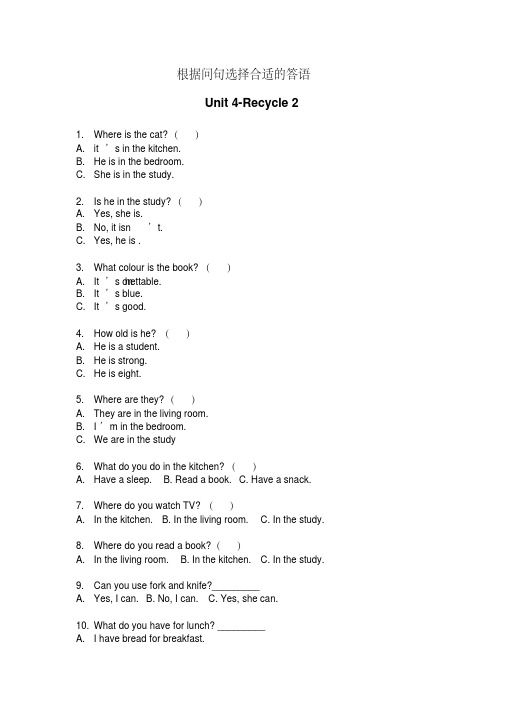
根据问句选择合适的答语Unit 4-Recycle 21. Where is the cat? ()A. it’s in the kitchen.B. He is in the bedroom.C. She is in the study.2. Is he in the study? ()A. Yes, she is.B. No, it isn’t.C. Yes, he is .3. What colour is the book? ()he table.A. It’s on tB. It’s blue.C. It’s good.4. How old is he? ()A. He is a student.B. He is strong.C. He is eight.5. Where are they? ()A. They are in the living room.B. I’m in the bedroom.C. We are in the study6. What do you do in the kitchen? ()A. Have a sleep.B. Read a book.C. Have a snack.7. Where do you watch TV? ()A. In the kitchen.B. In the living room.C. In the study.8. Where do you read a book? ()A. In the living room.B. In the kitchen.C. In the study.9. Can you use fork and knife?_________A. Yes, I can.B. No, I can.C. Yes, she can.10. What do you have for lunch? _________A. I have bread for breakfast.B. I have noodles for lunch.C. I have chicken for dinner.11. Is he in the study? _________A. No, he isn’t.B. Yes, he does.C. No, he doesn’t.12. Pass me a spoon. _________A. Here you are.B. Thank you.C. See you.13. Does he like milk? _________A. No, I don’t.B. No, it doesn’t.C. Yes, he does.14. Dinner’s ready. _________A. Yes.B. Thank you.C. Let’s go.15. Can you help me? _________A. No.B. Sure, here you are.C. Sure.16. What’s your brother? __________A. He’s a boy.B. He’s a student.C. He’s strong.17. Is your father a doctor? __________A. Yes, he isn’t.B. Yes, he is.C. No, he is.18. How many people are there in your family? __________A. Three.B. I have three.C. It’s three.19. Who is he? __________A. He is tall and strong.B. He is my baby brother.C. He’s ten years old.20. Is this your sister? __________A. Yes, her is .B. Yes, he is.C. Yes, she is.21. What would you like? __________A. I like my new book.B. I’d like some milk.C. I like music.22. Where is she? __________A. She is my sister.B. She is in the kitchen,C. She is an actor.23. What’s yo ur brother?_____________A. He is tall.B. Yes, he is.C. He is a driver.24. Can I have some rice? _____________A. No, I can’t.B. Yes, I can.C. Sure, here you are.25. How many people are there in your family? _____________A. I am five.B. There are five.C. I am fine.26. Where is your schoolbag? _____________A. Yes, it is.B. It’s on the table.C. Here you are.27. Who are they? _____________A. They are fine.B. They are my father, my mother and my sister.C. They are tall.28. What’s your si ster? _____________A. She is a girl.B. She is tall and nice.C. She is a doctor.29. Where is your mom? _____________A. She is a teacher.B. She’s in the living room.C. She’s a singer.30. What’s in your schoolbag? _____________A. An elephant, a dog and a duck.B. Two notebooks and a pencil-case.C. A desk, a chair and a board.31. What’s his name? _____________A. My name is Tom.B. Her name is Tom.C. His name is Tom.32. What would you like? _____________A. I like an apple.B. I’d like an apple.C. I like hot dog.。
四年级上册英语对话 根据问句找答语

四年级上册英语对话根据问句找答语1.A:Where are yo now? (你在哪儿?) B: I`m behind the door.(我在门)2.A:Excuse me !Where is No.2 park street ? B:Turn left. Turn right. Go straighton. 打扰一下,请问,公园街二号在哪儿?向左转,向右转,直着走。
3.A:Thank you so much! B:you`e welcome.非常感谢!不要客气。
4.A:Where`s the strain? B:It`s up the hill.火车在哪儿?它在山上。
5.What are you doing? B:I`m reading a book .你正在做什么?我正在读书。
6.A: What`s the ele phant doing ? B; It`s drawing pictures.大象正在做么?它在画画。
7.A:Do you want some rice? B:Yes,please. No,thank you.你想要些米饭吗?是的,请来点儿吧!不,谢谢。
8.A:Can I have some sweets? B: Yes ,youcan./here you are. Sorry,you can`t. 我可以吃些糖果吗?是的,可以。
给你。
对不起,不可以。
9A:How much is it? B: It`s ten yuan .它多少钱?它是十元。
10.A:Can you jump fast ? B:Yes ,I can. No ,I can`t.你会跳高吗?是的,我会。
不,我不会。
11.A:Can Sam play football? B: Yes, he can. No, he can`t.萨姆惠踢足球吗?是的,他会。
不,他不会。
12.A: Can lingling fly a kite? B: Yes, she can . No,she Can`t.玲玲会放风筝吗?是的,她会,不,她不会。
冀教版英语四年级下册句子与句型

冀教版英语四年级下册句子与句型Unit 1知识点1 介绍自己或他人名字的句型His name is Danny.他的名字是丹尼。
句型结构:My/his/her name is +名字例句:What’s his name?His name is John.重点解析:name前要使用形容词性物主代词。
知识点2 询问物品主人的句型Whose pencil is this?这是谁的铅笔。
I t’s Danny’s pencil.它是丹尼的铅笔。
句型结构问句:Whose +名词(短语)+is this?答语:It’s 形容词性物主代词/名词所有格+名词(短语)例句:Whose ruler is this?I t’s my ruler.重点解析:whose意为“谁的”,用于询问物品的归属。
问句和答句中的名词短语要用单数。
this 意为“这,这个”,用于指代单数物品。
知识点3 询问他人的位置的句型Where is Danny?丹尼在哪儿?He is in the classroom.他在教室里面。
句型结构问句:Where is +他人答语:He’s /She’s +表示方位的介词短语例句:Where is my dad,mum?He’s in the study.重点解析:由where开头的特殊疑问句,用于询问他人的位置。
where 与is可以缩写成where’s。
答句中的he或she用于指代问句中的“他人”。
Unit 2知识点1 序数词序数词表示事物的顺序,是由基数词转变而来的,表示“第……”,常与定冠词the连用。
序数词的构成形式:第一、第二、第三分别为:first,second,third.4-19的序数词通常由基数词加后缀“-th”构成,其中特殊的有:第五fifth,第八eighth,第九ninth,第十二twelfth。
整十的序数词,要先把基数词词尾的“-y”变成“-ie”,再加“-th”。
例如twenty one 二十一twenty-first,fifty-four 五十四fifty-fourth序数词的用法:做主语、宾语、表语和定语。
有问有答的句子有哪些四年级

有问有答的句子有哪些四年级作为语文老师,关于有问有答的句子,应当在四年级学生中有一定的涵盖面,让他们能够初步掌握这一语言交流的技巧。
有问有答的句子,顾名思义,就是一个问题与一个答案的回应,这样的句子在日常的交流中比比皆是。
在孩子们学习语言的时候,学会运用有问有答的句子将是很有帮助的。
在下面的文章当中,我将会列举三个例子,以详细解释有问有答句子的使用。
第一个例子是:“你住在哪里?” “我住在城市里。
”这是一个很基础的有问有答句子,这句话的意思是:“问句:你现在住在哪里?答句:我住在城市里。
”这个句子非常的常见,可以用于许多不同的场景。
当你想知道别人的住址时,或是当要接别人到某个地方时,你可以询问他们住在什么地方,然后对方可以用同样简单的方式回答你。
这个例子很适合用于小学四年级学生掌握。
第二个例子是:“你最喜欢的颜色是什么?” “我最喜欢的颜色是红色。
”这是一个询问喜好的例子。
问句:“你最喜欢的颜色是什么?”,答句:“我最喜欢的颜色是红色。
”在这个例子中,我们可以询问别人他们最喜欢的颜色,从而更好的了解听者的个人喜好。
当我们了解了别人的喜好之后,我们就可以更好的为他们服务或者与他们进行更深入的交流。
对于学生而言,使用这个例子来连通同学们的沟通是非常合适的。
第三个例子是:“你今天上午有什么安排吗?” “今天上午我要去上体育课。
”这是了解时间安排的有问有答句子。
问句:“你今天上午有什么安排吗?”,答句:“今天上午我要去上体育课。
”这个例子可以用于告诉别人你今天上午有哪些事情要做,也可以用于询问别人今天上午的时间安排。
在学习中,了解时间的分配是非常重要的,孩子们可以比较自然的掌握有问有答句子来询问别人今天的时间安排,从而更好的了解自己和别人的时间安排。
综上所述,有问有答的句子对于孩子们的语言素养学习来说是非常重要的。
在使用中,我们应该注意适当的场景和用途,从而让这些句子更加准确、流畅。
对于小学生而言,学习使用这些句子来交流将有助于他们更好的适应学校和生活中的语言环境。
自问自答造句四年级
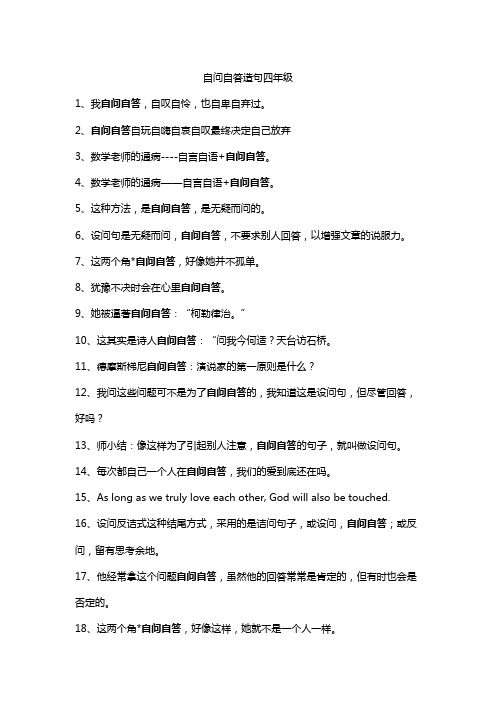
自问自答造句四年级1、我自问自答,自叹自怜,也自卑自弃过。
2、自问自答自玩自嗨自哀自叹最终决定自己放弃3、数学老师的通病----自言自语+自问自答。
4、数学老师的通病——自言自语+自问自答。
5、这种方法,是自问自答,是无疑而问的。
6、设问句是无疑而问,自问自答,不要求别人回答,以增强文章的说服力。
7、这两个角*自问自答,好像她并不孤单。
8、犹豫不决时会在心里自问自答。
9、她被逼著自问自答:“柯勒律治。
”10、这其实是诗人自问自答:“问我今何适?天台访石桥。
11、德摩斯梯尼自问自答:演说家的第一原则是什么?12、我问这些问题可不是为了自问自答的,我知道这是设问句,但尽管回答,好吗?13、师小结:像这样为了引起别人注意,自问自答的句子,就叫做设问句。
14、每次都自己一个人在自问自答,我们的爱到底还在吗。
15、As long as we truly love each other, God will also be touched.16、设问反诘式这种结尾方式,采用的是诘问句子,或设问,自问自答;或反问,留有思考余地。
17、他经常拿这个问题自问自答,虽然他的回答常常是肯定的,但有时也会是否定的。
18、这两个角*自问自答,好像这样,她就不是一个人一样。
19、傻孩子,我自问自答,如果不是“最不能接受的手段”,又如何配称为折磨。
20、是自问自答:是不是后一个比不上前一个聪明呢?我可以说:完全不是。
21、与自己进行对话—自问自答—似乎是一种很好的解决问题和理清想法的方式。
22、前者只问不答,要表达的确定意思包含在问句里;后者自问自答,以期引起读者注意,但二者均是疑问语气,因而句末都用问号。
23、运用设问句式自问自答,既能有力地凸显文章的观点,又给人耳目一新之感,收到良好的效果。
24、第三遍浏览(阅读各段第一句话),应根据该章卷内容自问自答呀些特殊问题。
25、发完一句疑问后打上一个问号必须后面再添上一句达成自问自答的效果才安心,避免了没人回答的尴尬26、由此可见,以问号有时还有疑问词为表现方式,明知故问,自问自答,以提醒注意、强化感情,这就是设问。
四年级上册给问句选答语专项训练
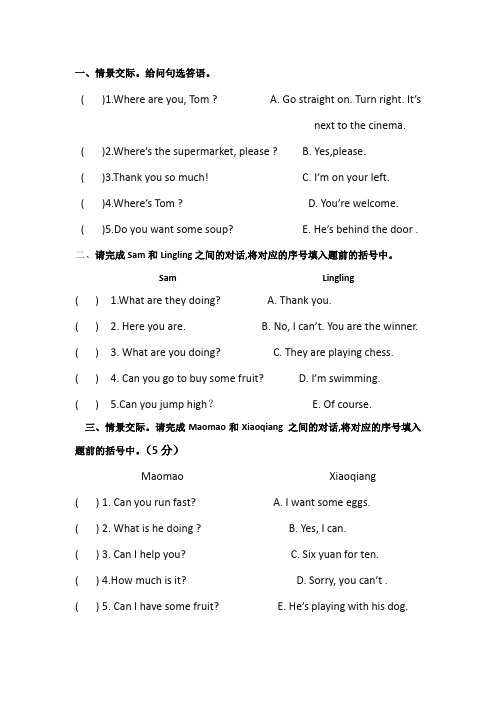
一、情景交际。
给问句选答语。
( )1.Where are you, Tom ? A. Go straight on. Turn right. It’snext to the cinema. ( )2.Where’s the supermarket, please ? B. Yes,please.( )3.Thank you so much! C. I’m on your left. ( )4.Where’s Tom ? D. You’re welcome. ( )5.Do you want some soup? E. He’s behind the door .二、请完成Sam和Lingling之间的对话,将对应的序号填入题前的括号中。
Sam Lingling( ) 1.What are they doing? A. Thank you.( ) 2. Here you are. B. No, I can’t. You are the winner. ( ) 3. What are you doing? C. They are playing chess. ( ) 4. Can you go to buy some fruit? D. I’m swimming.( ) 5.Can you jump high? E. Of course.三、情景交际。
请完成Maomao和Xiaoqiang 之间的对话,将对应的序号填入题前的括号中。
(5分)Maomao Xiaoqiang( ) 1. Can you run fast? A. I want some eggs.( ) 2. What is he doing ? B. Yes, I can.( ) 3. Can I help you? C. Six yuan for ten.( ) 4.How much is it? D. Sorry, you can’t . ( ) 5. Can I have some fruit? E. He’s playing with his dog.。
【专项集训】人教PEP版四年级英语下册期末总复习-答语匹配题(含答案)

人教PEP版(三起)四年级英语期末总复习专项训练【题型】答语匹配题一、给下列问句选择正确的答语。
()1.What are these?()2.Are these potatoes?()3.How many horses do you have?()4.What time is it?()5.What’s the weather like in Beijing?二、给问句选出合适的答语,将序号填在括号里。
(()2. Is this your shirt?()3. Where is my T-shirt?()4. What colour are the pants?()5. Whose hat is this?三、给问句选出合适的答语,将序号填在括号里。
()1.What's the weather like in Kunming? ()2.Is it cold outside?()3.Dad, let's fly a kite.()4.Mom, can I put on my shoes?()5.Whose cap is this?四、给问句选出合适的答语,将序号填在括号里。
(()2. Where is the T-shirt?()3. Are they jeans?()4. Whose is that?()5. Is this your skirt?五、给问句选出合适的答语,将序号填在括号里。
(()2. Are these yours?()3. It's cold outside. Put on your hat.()4. Is this Mike's?()5. Mum, can I wash my skirt?六、给问句选出合适的答语,将序号填在括号里。
A.Yes, I do.B.Yes, they are.C.No, it isn’t.D.Yes.E.They’re 120 yuan.()2.Is the sweater cheap?()3.Are the gloves nice?()4.How much are the sunglasses?()5.Do you like the red umbrella?七、给问句选出合适的答语,将序号填在括号里。
- 1、下载文档前请自行甄别文档内容的完整性,平台不提供额外的编辑、内容补充、找答案等附加服务。
- 2、"仅部分预览"的文档,不可在线预览部分如存在完整性等问题,可反馈申请退款(可完整预览的文档不适用该条件!)。
- 3、如文档侵犯您的权益,请联系客服反馈,我们会尽快为您处理(人工客服工作时间:9:00-18:30)。
1.Are you ready for school?
2.Whose pencil is this?
3.Is this your pencil, jenny?
4.What are these?
5.How many books do I have on my desk?
6.How many books are there on my desk?
7.Where is kim?
8.What is he doing?
10.When is your birthday?
11.What’s the date?
12.What day is it?
13.When is New Year’s Day.
14.How’s the weather today?
15.How’s the weather in December?
16.What time is it? Yes!
Sixteen.
She is on the playground.
He is reading a book.
It’s Danny’ spencil.
My birthday is in July.
It’s warm and windy.
No, it’s not my pencil.
They are pens.
It’s seven o’clock.
You have eight books.
It’s Tuesday.
January first is Now Year’s Day.
It’s cold and snowy.
It’s March thirteenth.
17.What time do you go to school?
18.Nice to see you again.
1.How old are you?
2.When is your birthday?
3.How tall are you?
6.What are you wearing?
7.Where do you live?
8.Whice floor do you live on?
9.What’s your address?
10.How do you go to school?
11.What’s your favourite colour?
12.What’s your favourite clothes?
13.What’s your favourite food?
14.What’s your favourite Subject.?
15.What do you like to do?
I’m nineteen years old.
My birthday is on December
I go to school at eight o’clock.
Nice to see you, too.
I’m 1.3 metres tall.
I’m wearing shorts.
I live in a house near the park.
My favourite colour is green.
I like to play basketball.
I live on the second floor.
I go to school by bus.
My favourite clothes are shorts.
My favourite food is sandwich.
My favourite food is sandwich.
My address is 135 Ninth Avenue.。
